A New Hydro-Mechanical Coupling Numerical Model for Predicting Water Inflow in Karst Tunnels Considering Deformable Fracture
Abstract
:1. Introduction
2. Governing Equation
2.1. Mechanical Response
2.2. Constitutive Model for Fracture
2.3. Unsaturated Flow
2.4. Hydro-Mechanical Coupling Process
- Generate model and mesh with geological information.
- Generate embedded DFNs with DFN information including density and incline angle.
- Initiate the mechanic parameter and configure the boundary condition in FLAC3D.
- Prepare the input file, initiate hydraulic parameter, and configure the boundary condition in TOUGH.
- Run the coupling framework of TOUGH-FLAC3D till the time limit.
- Result evaluation.
2.5. Fracture Shear Behavior Validation
2.5.1. Geological Information and Model Configuration
2.5.2. Configuration of Numerical Model
3. Results and Discussion
3.1. Numerical Results
3.2. Effects of Fracture Density
3.3. Effects of Inclination Angles
3.4. Effects of Stress Anisotropy
3.5. Effects of Initial Fracture Width
4. Conclusions
- (1)
- The trend and value of the inflow rate predicted by the proposed numerical model have good consistency with the values observed on site in Jianxing Tunnel, proving that the equivalent fracture model is feasible for predicting the water inflow of fractured karst tunnels.
- (2)
- In the fractured model, the steady inflow rate reaches the steady state much faster than in the unfractured model. Moreover, the highest transient and steady rates are much higher in the fractured model, by a factor of approximately 100.
- (3)
- The stress distribution due to the excavation induced slippage on the fractures around the tunnel, at an impact distance of approximately 8.2 m from the tunnel wall.
- (4)
- The increased fracture width due to shear dilatation on the fracture increases the tunnel inflow rate by approximately 50%, highlighting the importance of mechanical effects on tunnel inflow, particularly during tunnel construction.
- (5)
- The fracture density, dip angle, stress anisotropy, and initial fracture width have significant impact on the inflow rate, with the order dip angle > initial fracture width > fracture density > stress anisotropy. When using the proposed model to predict water inflow, values should be taken based on actual geological environmental conditions.
Author Contributions
Funding
Conflicts of Interest
References
- Huang, Q.; Peng, J.; Wang, F.; Lliu, N. Issues and challenges in the development of urban underground space in adverse geological environment. Earth Sci. Front. 2019, 26, 85–94. [Google Scholar] [CrossRef]
- Ma, J.; Guan, J.; Duan, J.; Huang, L.; Liang, Y. Stability analysis on tunnels with karst caves using the distinct lattice spring model. Undergr. Space 2021, 6, 469–481. [Google Scholar] [CrossRef]
- Liu, N.; Pei, J.; Cao, C.; Liu, X.; Huang, Y.; Mei, G. Geological investigation and treatment measures against water inrush hazard in karst tunnels: A case study in Guiyang, southwest China. Tunn. Undergr. Space Technol. 2022, 124, 104491. [Google Scholar] [CrossRef]
- Zhang, Q.; Tian, S.; Mo, Y.; Dong, X.; Hao, S. An expert system for prediction of Karst disaster in excavation of tunnels or underground structures through a carbonate rock area. Tunn. Undergr. Space Technol. 1993, 8, 373–378. [Google Scholar] [CrossRef]
- Zheng, Y.; Yan, J.; Su, R.; Ma, S.; Li, Y.; Wang, X.; Zheng, J.; Zhu, Y.; Yu, Y. Investigation of the settlement mechanism and control measures of a super-large section tunnel in a giant karst cave using ultra-thick backfill method. Tunn. Undergr. Space Technol. 2023, 137, 104956. [Google Scholar] [CrossRef]
- Jing, H.; Wu, J.; Yin, Q.; Wang, K. Deformation and failure characteristics of anchorage structure of surrounding rock in deep roadway. Int. J. Min. Sci. Technol. 2020, 30, 593–604. [Google Scholar] [CrossRef]
- Berisavljević, Z.; Bajić, D.; Jovičić, V. Development and Application of Methodology for Quantification of Overbreaks in Hard Rock Tunnel Construction. Appl. Sci. 2023, 13, 1379. [Google Scholar]
- Wang, J.; Li, S.; Li, L.; Xu, Z. Dynamic evolution characteristics and prediction of water Inflow of karst piping-type Water Inrush of Tunnels. Chin. J. Geotech. Eng. 2018, 40, 1880–1888. [Google Scholar]
- Shi, S.; Guo, W.; Li, S.; Xie, X.; Li, X.; Zhao, R.; Xue, Y.; Lu, J. Prediction of tunnel water inflow based on stochastic deterministic three-dimensional fracture network. Tunn. Undergr. Space Technol. 2023, 135, 104997. [Google Scholar] [CrossRef]
- Kong, W.K. Water Ingress Assessment for Rock Tunnels: A Tool for Risk Planning. Rock Mech. Rock Eng. 2011, 44, 755–765. [Google Scholar] [CrossRef]
- Raymer, J. Groundwater inflow into hard rock tunnels. Tunn. Tunn. Int. 2001, 33, 50–53. [Google Scholar]
- Wu, J.; Zhou, Z.; Zhuang, C. A combined analytical-numerical method for groundwater inflow into circular tunnels in drained conditions. Hydrogeol. J. 2021, 29, 2529–2543. [Google Scholar] [CrossRef]
- Li, L.; Sun, S.; Wang, J.; Yang, W.; Song, S.; Fang, Z. Experimental study of the precursor information of the water inrush in shield tunnels due to the proximity of a water-filled cave. Int. J. Rock Mech. Min. Sci. 2020, 130, 104320. [Google Scholar] [CrossRef]
- Liang, D.-x.; Jiang, Z.-q.; Zhu, S.-y.; Sun, Q.; Qian, Z.-w. Experimental research on water inrush in tunnel construction. Nat. Hazards 2016, 81, 467–480. [Google Scholar] [CrossRef]
- Wang, Y.; Chen, F.; Sui, W.; Meng, F.; Geng, F. Large-scale model test for studying the water inrush during tunnel excavation in fault. Bull. Eng. Geol. Environ. 2022, 81, 238. [Google Scholar] [CrossRef]
- Ma, J.; Zhao, J.; Lin, Y.; Liang, J.; Chen, J.; Chen, W.; Huang, L. Study on Tamped Spherical Detonation-Induced Dynamic Responses of Rock and PMMA Through Mini-chemical Explosion Tests and a Four-Dimensional Lattice Spring Model. Rock Mech. Rock Eng. 2023, 56, 7357–7375. [Google Scholar] [CrossRef]
- Sweetenham, M.G.; Maxwell, R.M.; Santi, P.M. Assessing the timing and magnitude of precipitation-induced seepage into tunnels bored through fractured rock. Tunn. Undergr. Space Technol. 2017, 65, 62–75. [Google Scholar] [CrossRef]
- Peng, X.; Yu, P.; Cheng, X.; Chen, G.; Zhang, Y.; Zhang, H.; Li, C. Dynamic simulation of the water inrush process in tunnel construction using a three-dimensional coupled discontinuous deformation analysis and smoothed particle hydrodynamics method. Tunn. Undergr. Space Technol. 2022, 127, 104612. [Google Scholar] [CrossRef]
- Li, Z.; Wang, Y.; Olgun, G.; Yang, S.-Q.; Jiao, Q.; Wang, M. Risk assessment of water inrush caused by karst cave in tunnels based on reliability and GA-BP neural network. Geomat. Nat. Hazards Risk 2020, 11, 1212–1232. [Google Scholar] [CrossRef]
- Liu, D.; Xu, Q.; Tang, Y.; Jian, Y. Prediction of Water Inrush in Long-Lasting Shutdown Karst Tunnels Based on the HGWO-SVR Model. IEEE Access 2021, 9, 6368–6378. [Google Scholar] [CrossRef]
- Li, S.-c.; He, P.; Li, L.-p.; Shi, S.-s.; Zhang, Q.-q.; Zhang, J.; Hu, J. Gaussian process model of water inflow prediction in tunnel construction and its engineering applications. Tunn. Undergr. Space Technol. 2017, 69, 155–161. [Google Scholar] [CrossRef]
- Li, Y.; Zhang, D.; Fang, Q.; Yu, Q.; Xia, L. A physical and numerical investigation of the failure mechanism of weak rocks surrounding tunnels. Comput. Geotech. 2014, 61, 292–307. [Google Scholar] [CrossRef]
- Miccoli, L.; Garofano, A.; Fontana, P.; Müller, U. Experimental testing and finite element modelling of earth block masonry. Eng. Struct. 2015, 104, 80–94. [Google Scholar] [CrossRef]
- Wu, J.; Jing, H.; Yin, Q.; Yu, L.; Meng, B.; Li, S. Strength prediction model considering material, ultrasonic and stress of cemented waste rock backfill for recycling gangue. J. Clean. Prod. 2020, 276, 123189. [Google Scholar] [CrossRef]
- Wu, J.; Jing, H.; Gao, Y.; Meng, Q.; Yin, Q.; Du, Y. Effects of carbon nanotube dosage and aggregate size distribution on mechanical property and microstructure of cemented rockfill. Cem. Concr. Compos. 2022, 127, 104408. [Google Scholar] [CrossRef]
- Karimzade, E.; Sharifzadeh, M.; Zarei, H.R.; Shahriar, K.; Cheraghi Seifabad, M. Prediction of water inflow into underground excavations in fractured rocks using a 3D discrete fracture network (DFN) model. Arab. J. Geosci. 2017, 10, 206. [Google Scholar] [CrossRef]
- Chen, T.; Yin, H.; Zhai, Y.; Xu, L.; Zhao, C.; Zhang, L. Numerical Simulation of Mine Water Inflow with an Embedded Discrete Fracture Model: Application to the 16112 Working Face in the Binhu Coal Mine, China. Mine Water Environ. 2022, 41, 156–167. [Google Scholar] [CrossRef]
- Han, G.; Jing, H.; Jiang, Y.; Liu, R.; Wu, J. Effect of Cyclic Loading on the Shear Behaviours of Both Unfilled and Infilled Rough Rock Joints Under Constant Normal Stiffness Conditions. Rock Mech. Rock Eng. 2020, 53, 31–57. [Google Scholar] [CrossRef]
- Yin, Q.; Nie, X.; Wu, J.; Wang, Q.; Bian, K.; Jing, H. Experimental study on unloading induced shear performances of 3D saw-tooth rock fractures. Int. J. Min. Sci. Technol. 2023, 33, 463–479. [Google Scholar] [CrossRef]
- Bandis, S.C.; Lumsden, A.C.; Barton, N.R. Fundamentals of rock joint deformation. Int. J. Rock Mech. Min. Sci. Geomech. Abstr. 1983, 20, 249–268. [Google Scholar] [CrossRef]
- Ma, J.; Chen, J.; Chen, W.; Huang, L. A coupled thermal-elastic-plastic-damage model for concrete subjected to dynamic loading. Int. J. Plast. 2022, 2022, 103279. [Google Scholar] [CrossRef]
- Zhou, L.; Su, X.; Lu, Y.; Ge, Z.; Zhang, Z.; Shen, Z. A New Three-Dimensional Numerical Model Based on the Equivalent Continuum Method to Simulate Hydraulic Fracture Propagation in an Underground Coal Mine. Rock Mech. Rock Eng. 2019, 52, 2871–2887. [Google Scholar] [CrossRef]
- Zhang, K.; Yamamoto, H.; Pruess, K. TMVOC-MP: A Parallel Numerical Simulator for Three-PhaseNon-Isothermal Flows of Multicomponent Hydrocarbon Mixtures Inporous/Fractured Media; Lawrence Berkeley National Lab.: Berkeley, CA, USA, 2007. [Google Scholar] [CrossRef]
- Lin, Y.; Ma, J.; Lai, Z.; Huang, L.; Lei, M. A FDEM approach to study mechanical and fracturing responses of geo-materials with high inclusion contents using a novel reconstruction strategy. Eng. Fract. Mech. 2023, 282, 109171. [Google Scholar] [CrossRef]
- Liao, J.; Hu, K.; Mehmood, F.; Xu, B.; Teng, Y.; Wang, H.; Hou, Z.; Xie, Y. Embedded discrete fracture network method for numerical estimation of long-term performance of CO2-EGS under THM coupled framework. Energy 2023, 285, 128734. [Google Scholar] [CrossRef]
- Farhadian, H.; Katibeh, H.; Huggenberger, P. Empirical model for estimating groundwater flow into tunnel in discontinuous rock masses. Environ. Earth Sci. 2016, 75, 471. [Google Scholar] [CrossRef]
- Maleki, M.; Imani, M. Active lateral pressure to rigid retaining walls in the presence of an adjacent rock mass. Arab. J. Geosci. 2022, 15, 152. [Google Scholar] [CrossRef]
- Maleki, M.; Khezri, A.; Nosrati, M.; Hosseini, S.M.M.M. Seismic amplification factor and dynamic response of soil-nailed walls. Model. Earth Syst. Environ. 2023, 9, 1181–1198. [Google Scholar] [CrossRef]
- Farhadian, H.; Nikvar-Hassani, A. Water flow into tunnels in discontinuous rock: A short critical review of the analytical solution of the art. Bull. Eng. Geol. Environ. 2019, 78, 3833–3849. [Google Scholar] [CrossRef]
- Fernandez, G.; Moon, J. Excavation-induced hydraulic conductivity reduction around a tunnel—Part 1: Guideline for estimate of ground water inflow rate. Tunn. Undergr. Space Technol. 2010, 25, 560–566. [Google Scholar] [CrossRef]
- Li, G.; Hu, Y.; Tian, S.M.; Weibin, M.; Huang, H.L. Analysis of deformation control mechanism of prestressed anchor on jointed soft rock in large cross-section tunnel. Bull. Eng. Geol. Environ. 2021, 80, 9089–9103. [Google Scholar]
- Alotaibi, M.; Alotaibi, S.; Weijermars, R. Stream and Potential Functions for Transient Flow Simulations in Porous Media with Pressure-Controlled Well Systems. Fluids 2023, 8, 160. [Google Scholar] [CrossRef]
- Molinero, J.; Samper, J.; Juanes, R. Numerical modeling of the transient hydrogeological response produced by tunnel construction in fractured bedrocks. Eng. Geol. 2002, 64, 369–386. [Google Scholar] [CrossRef]
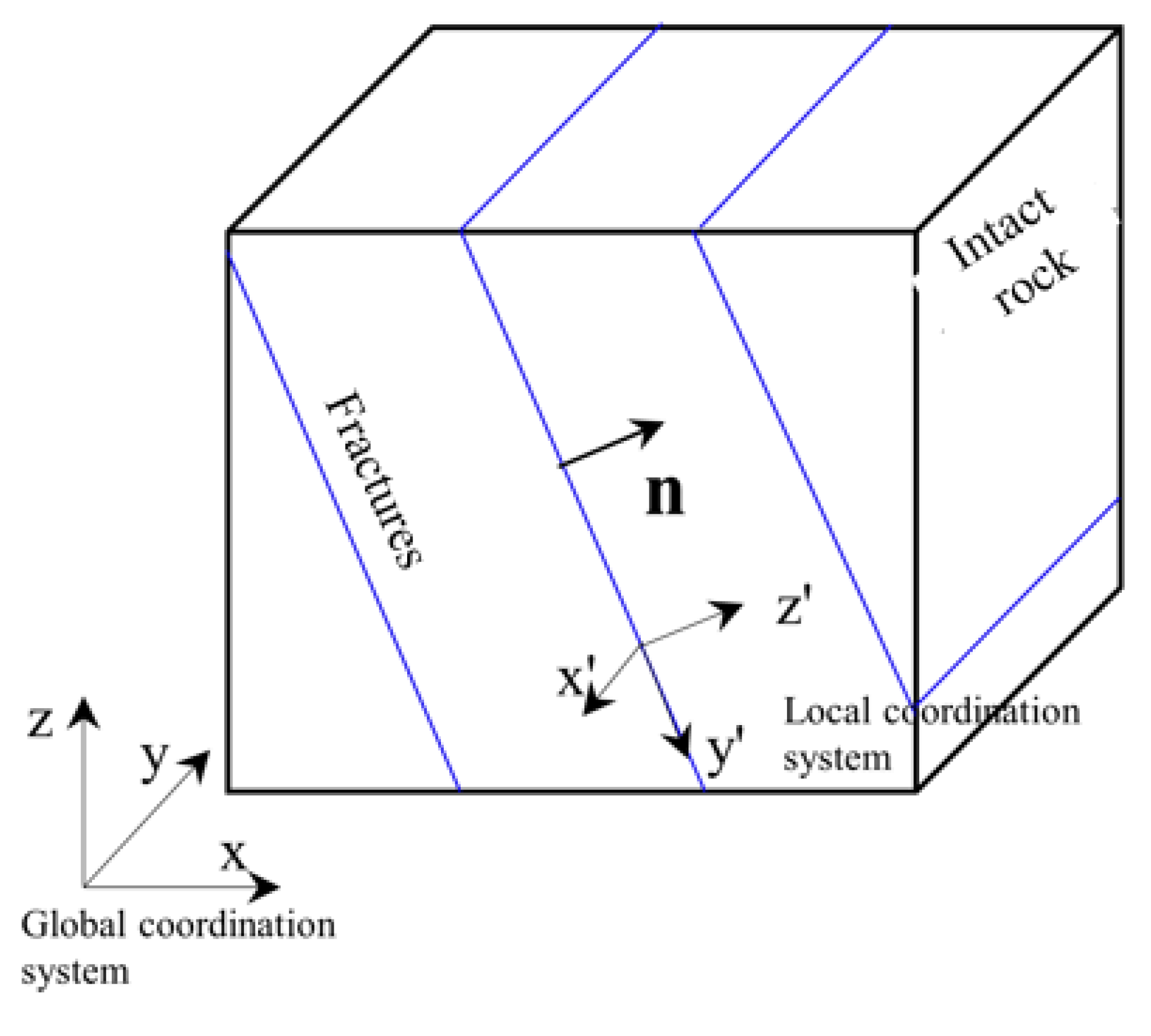
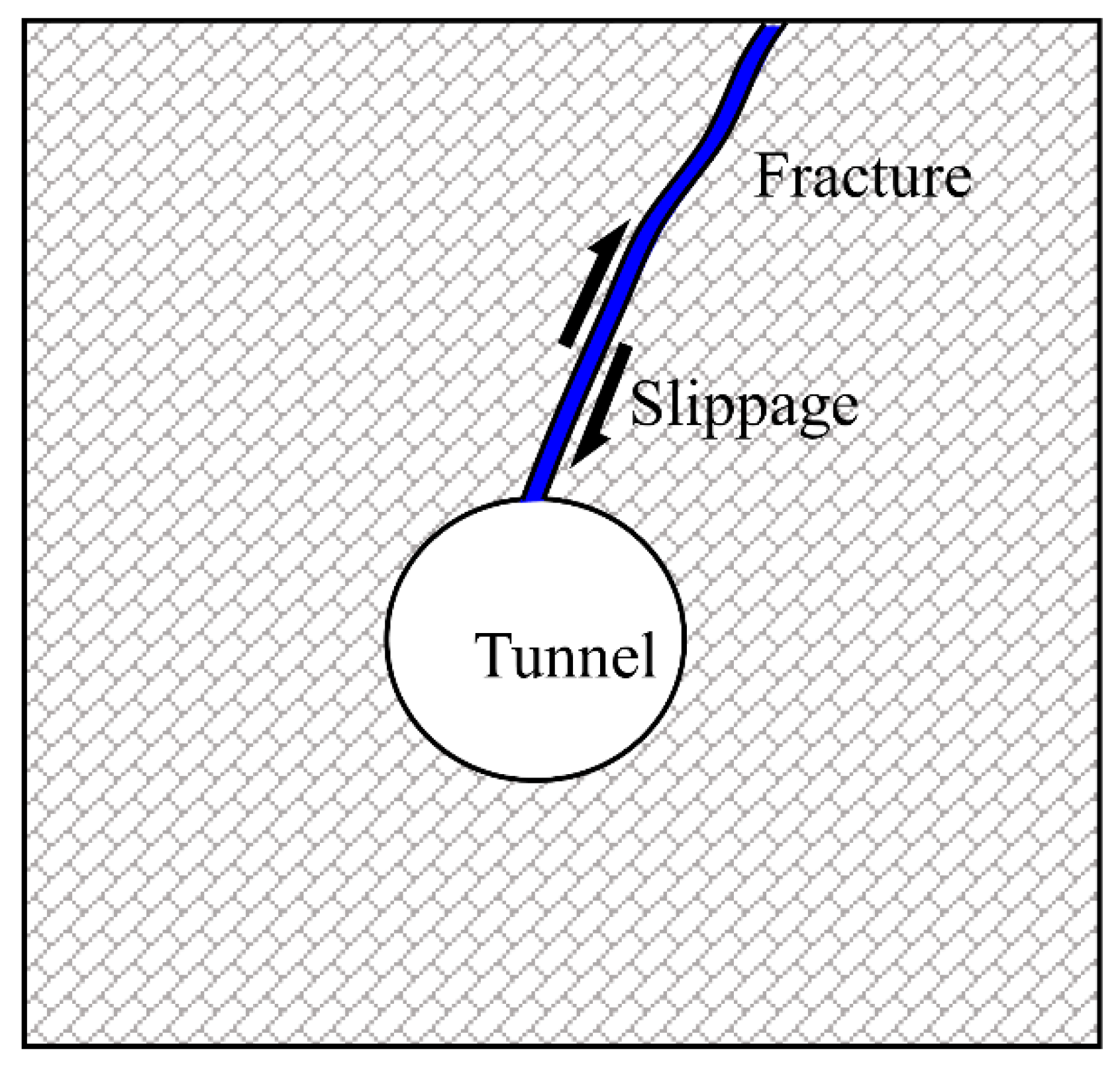

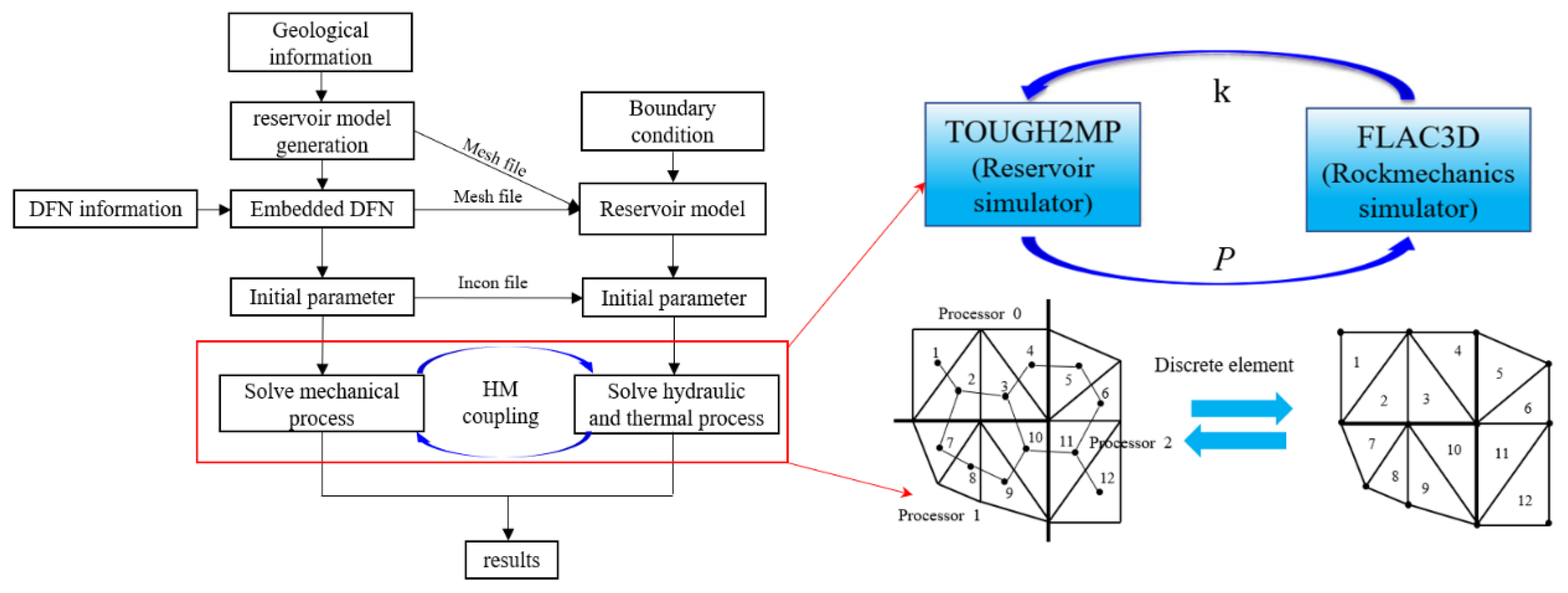
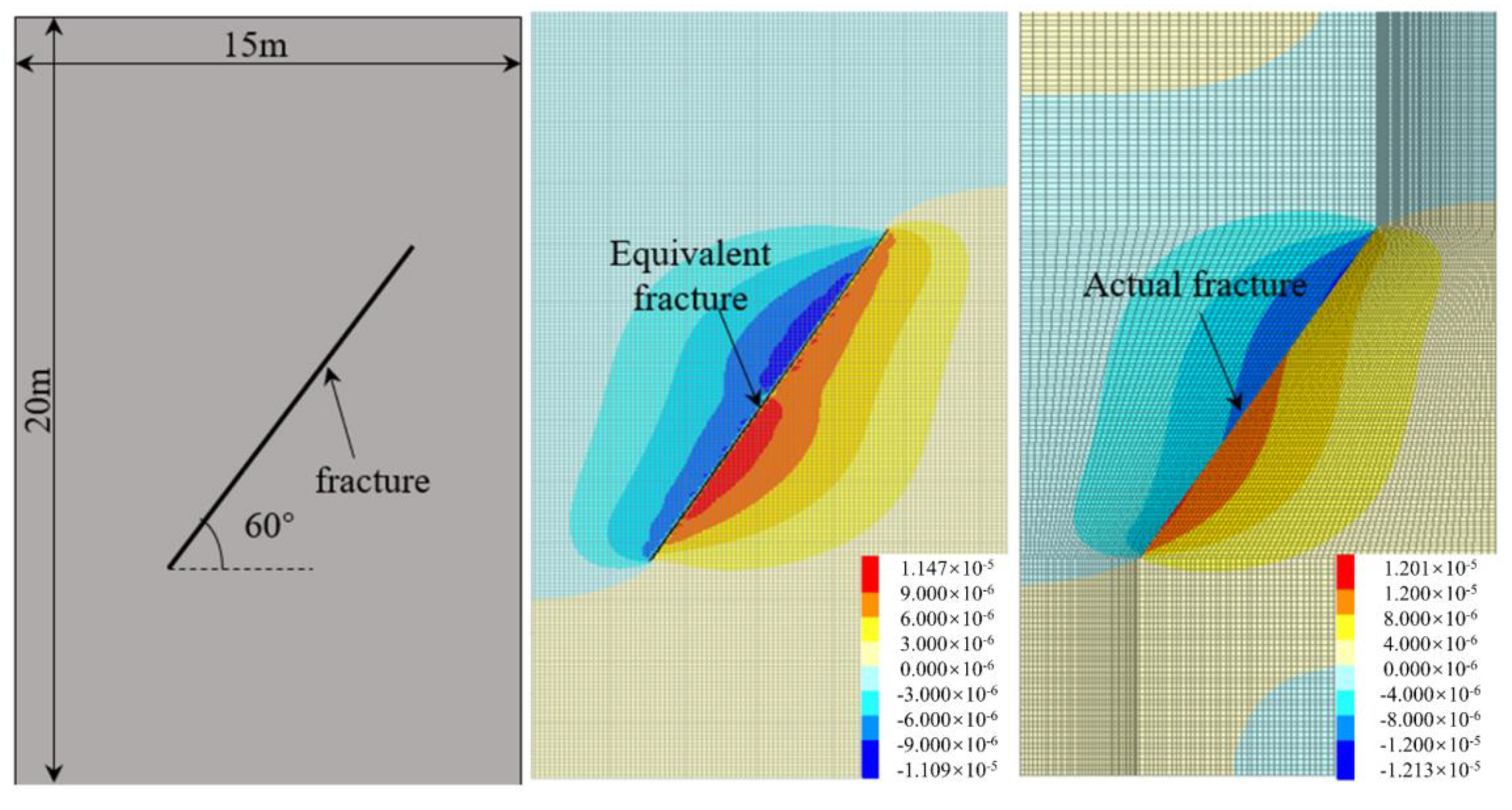

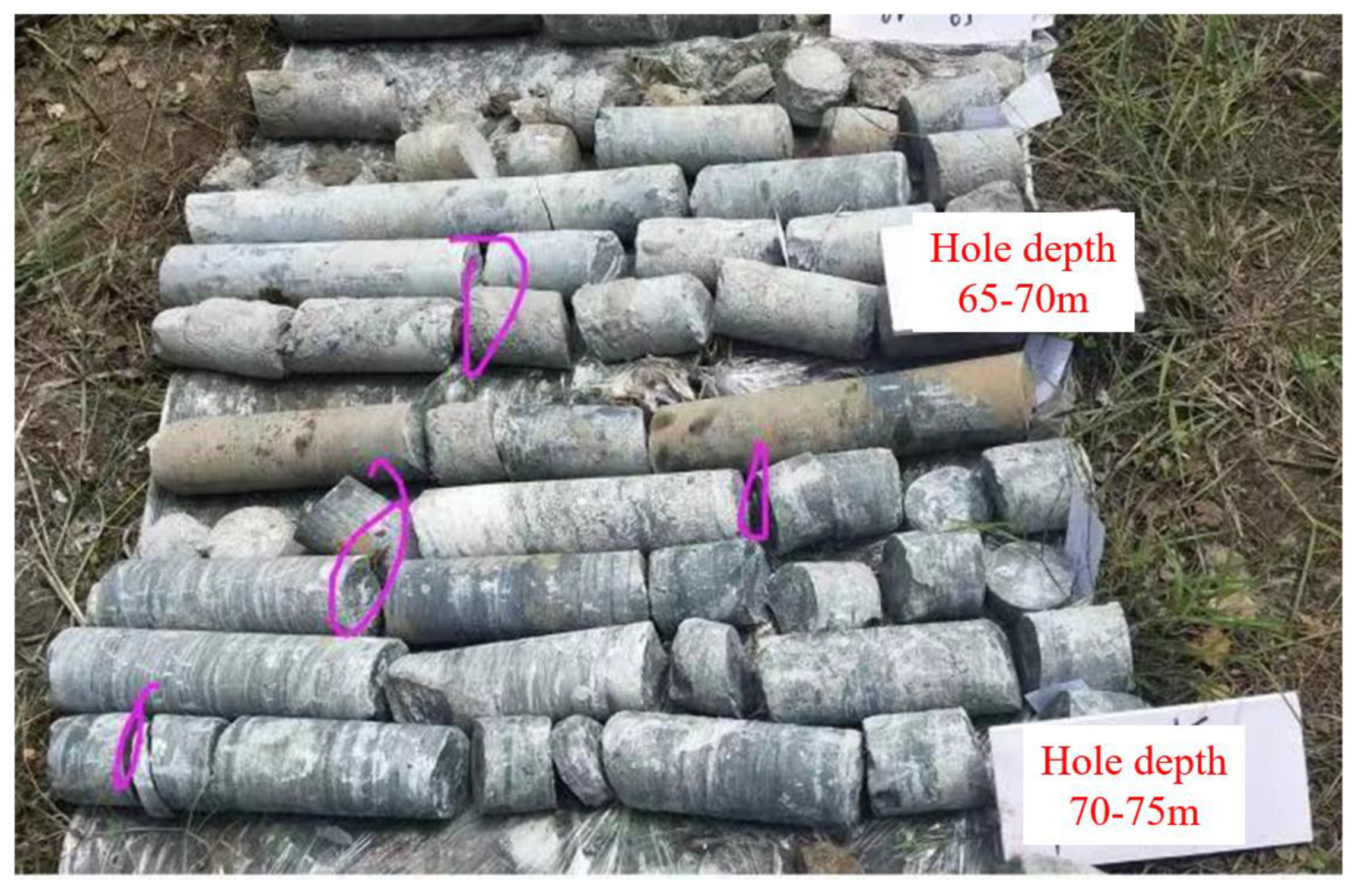
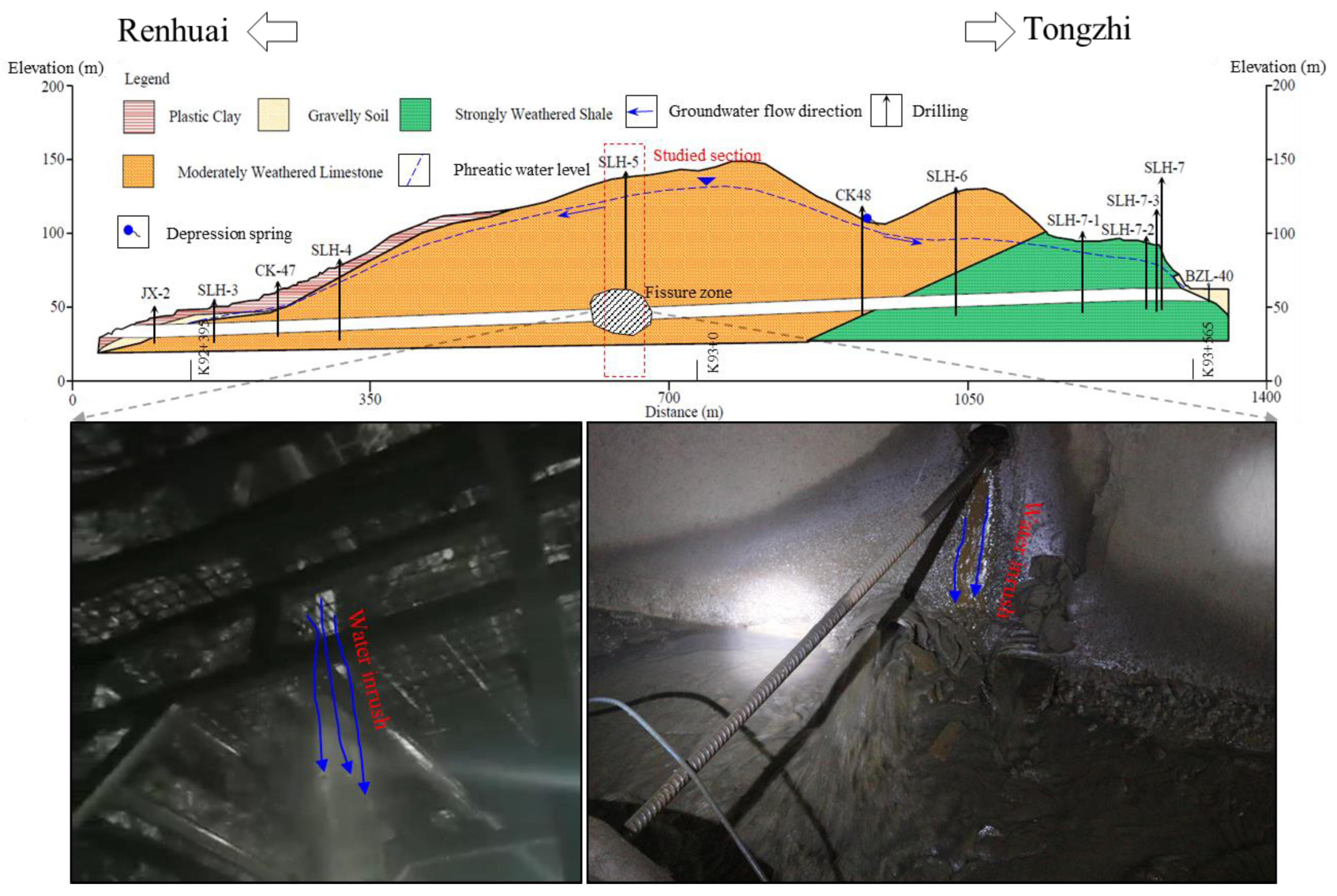
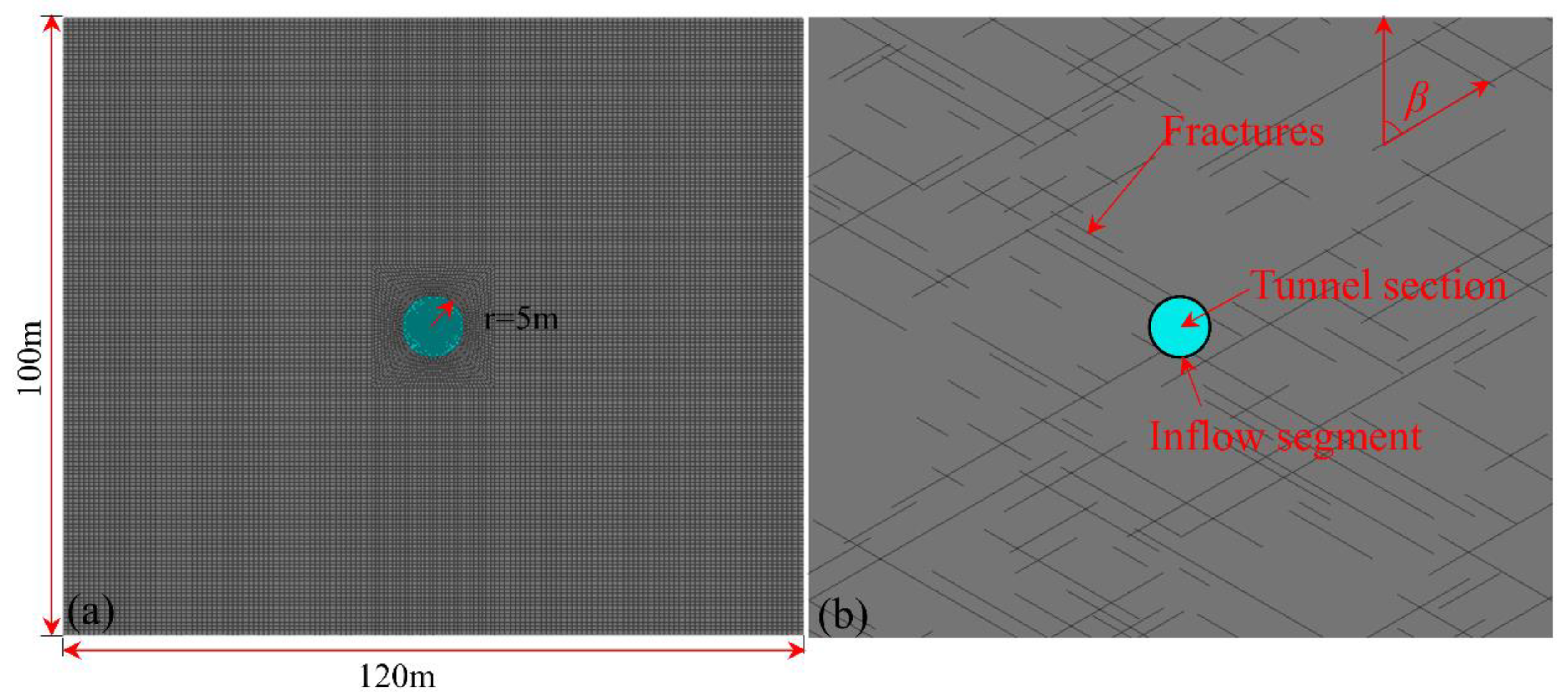
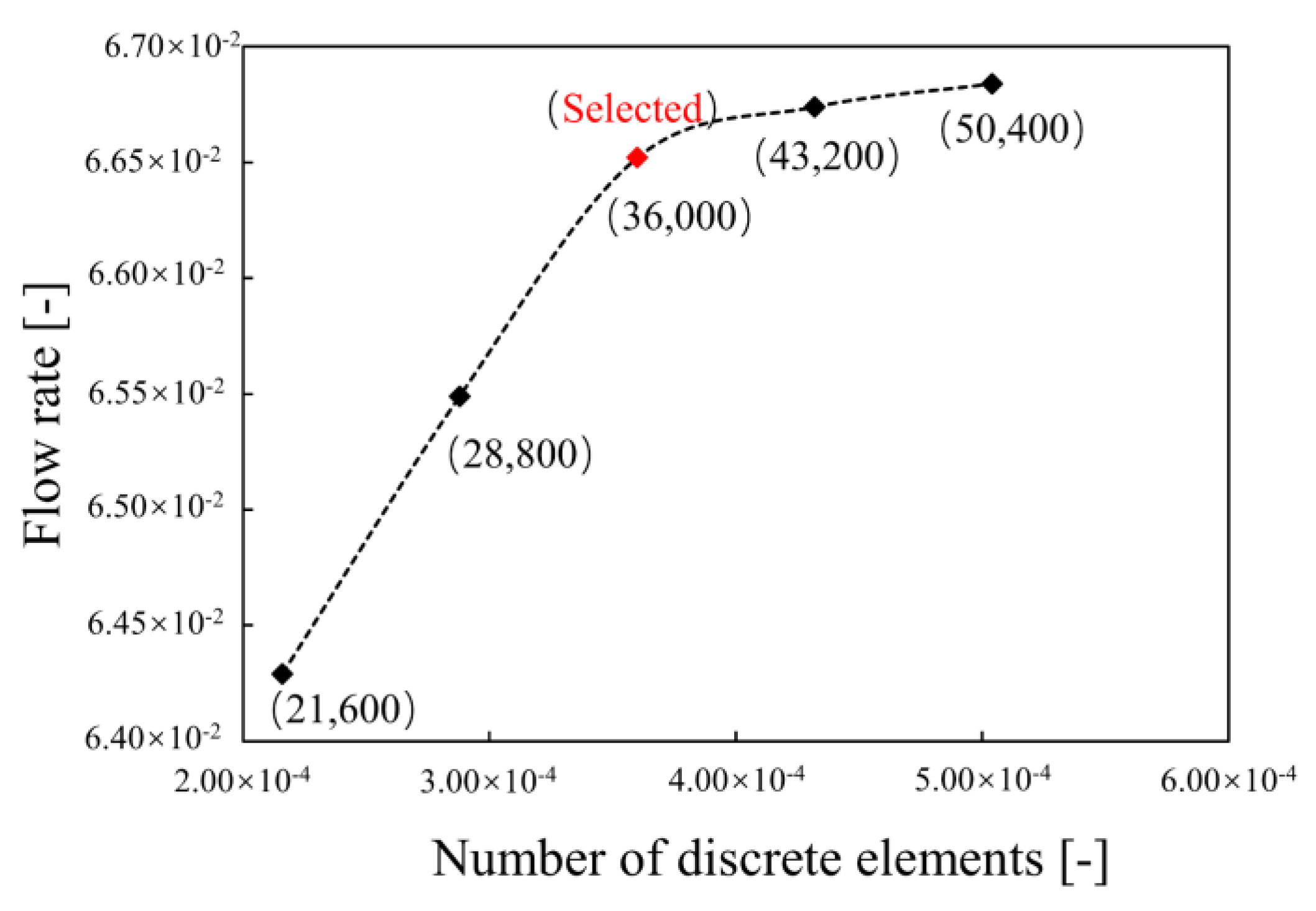
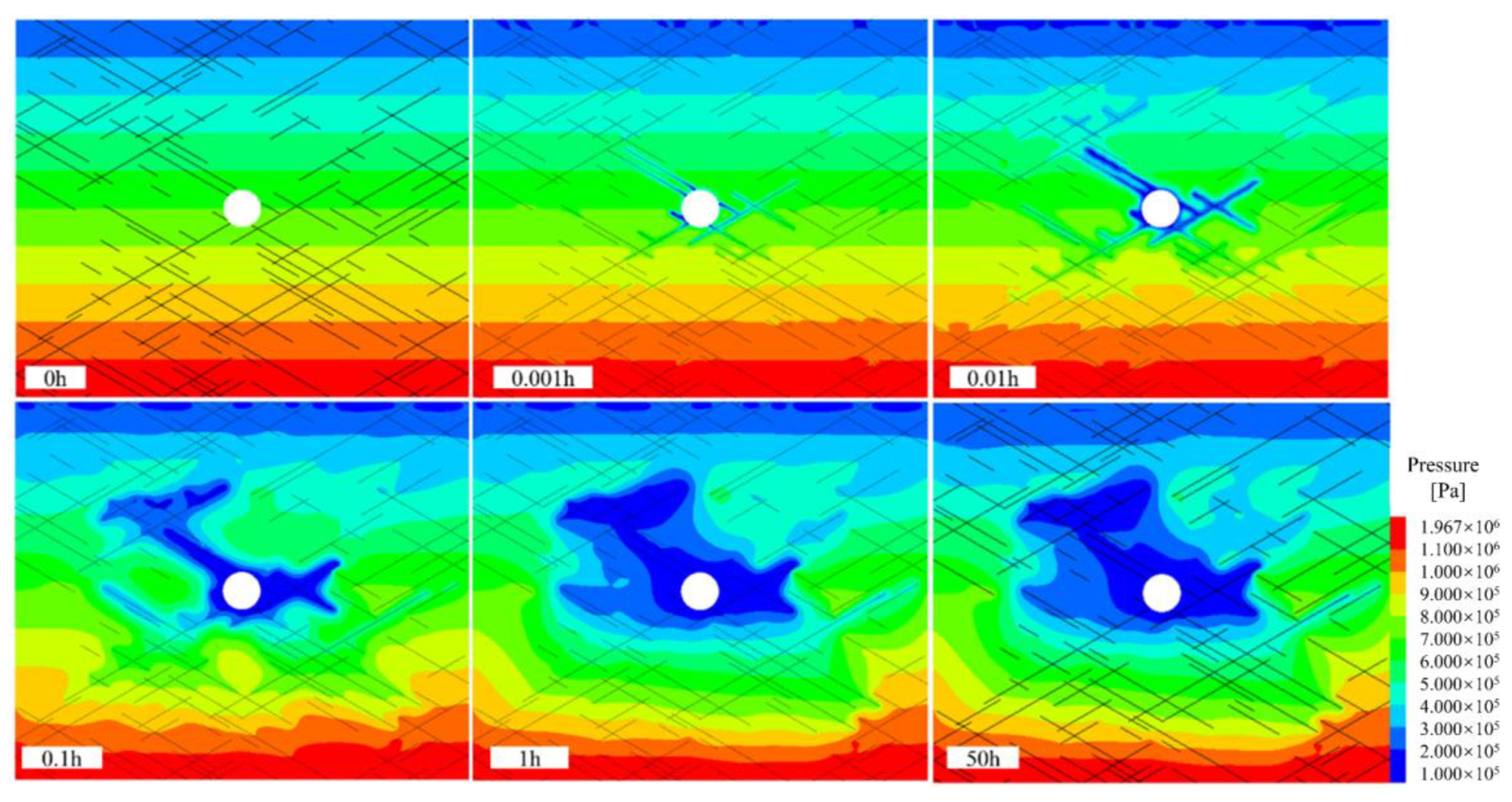
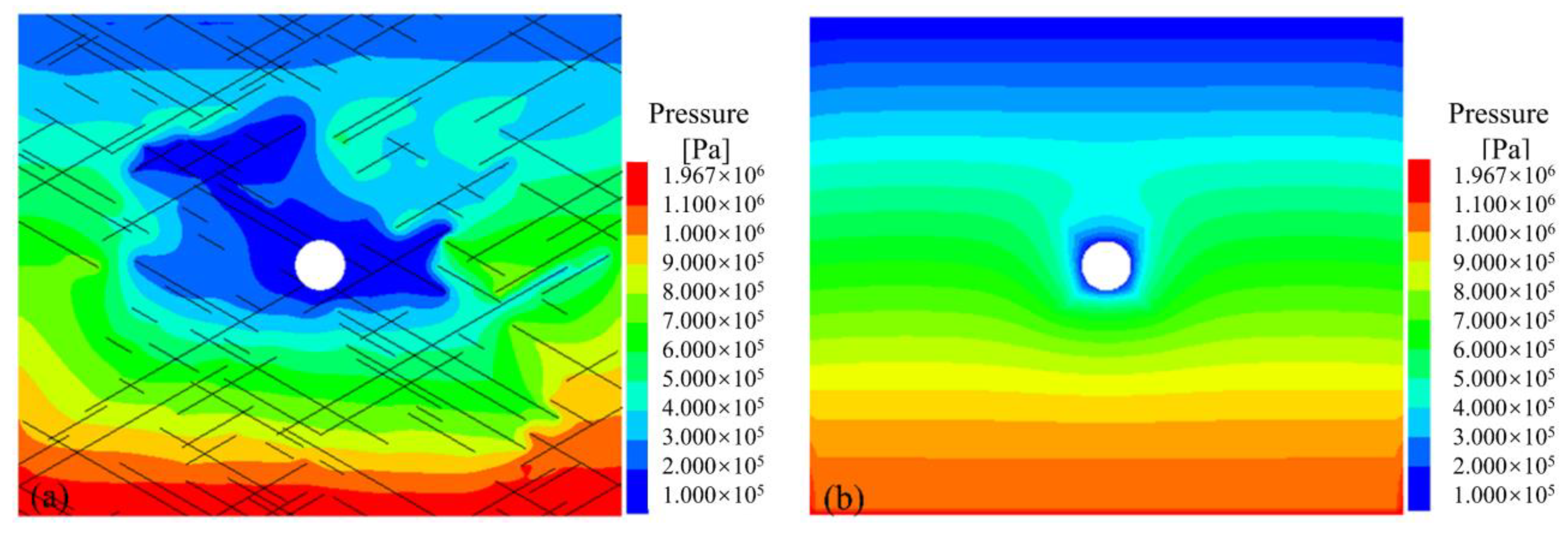


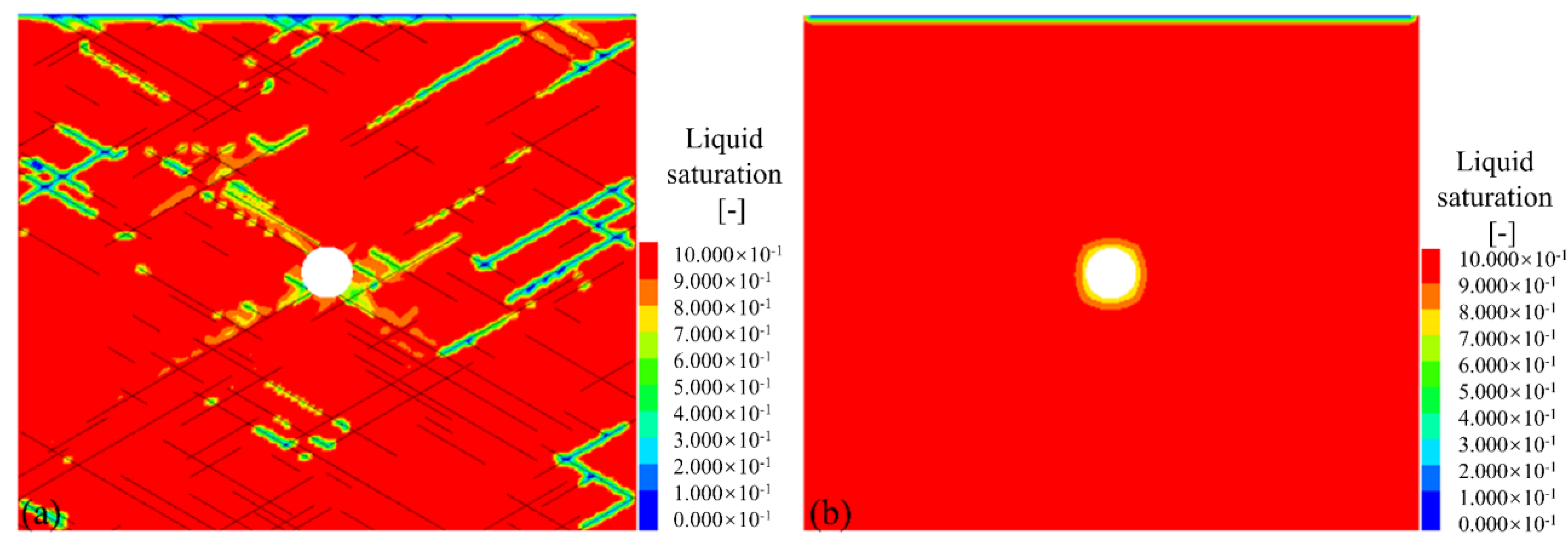


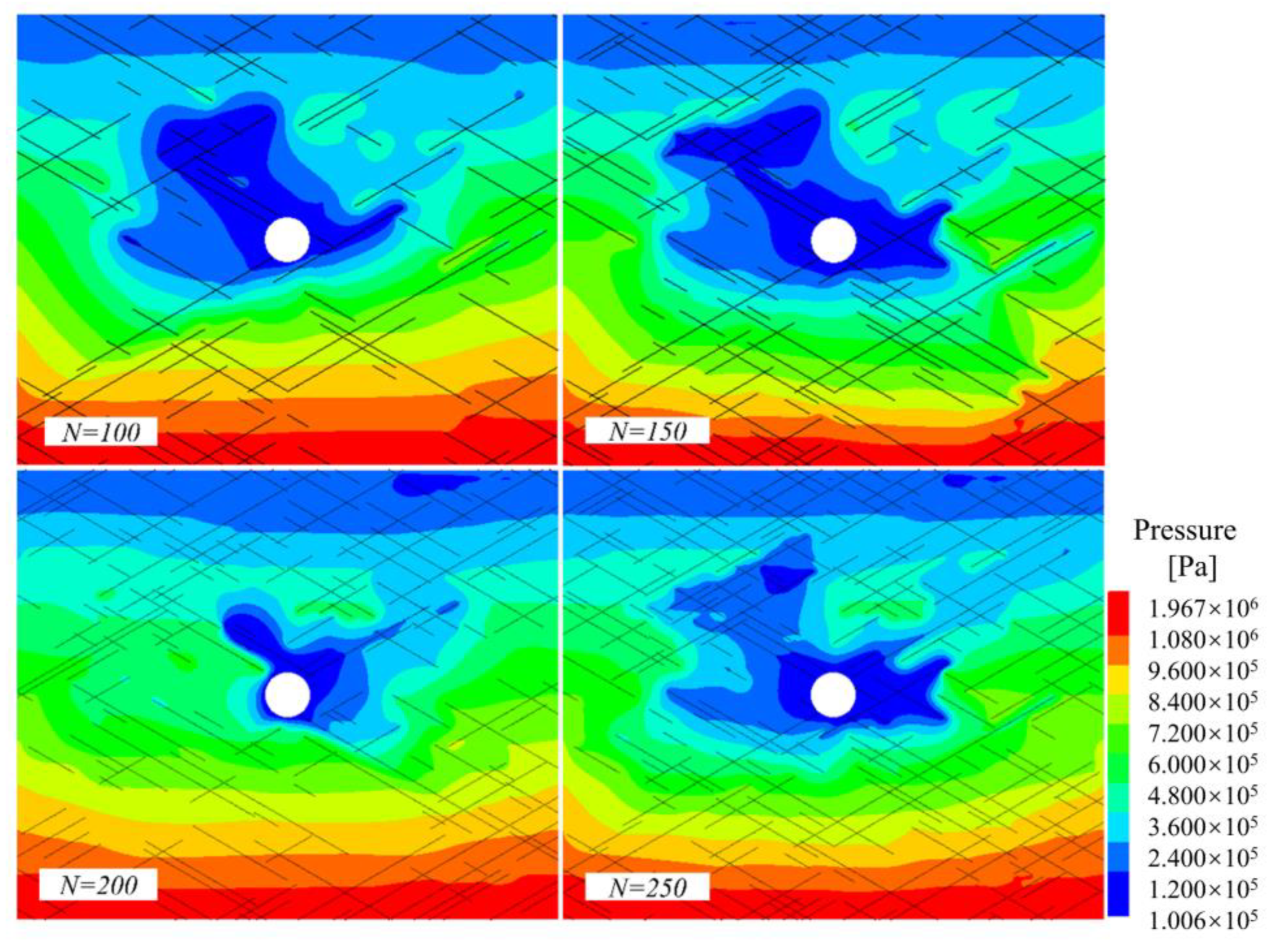

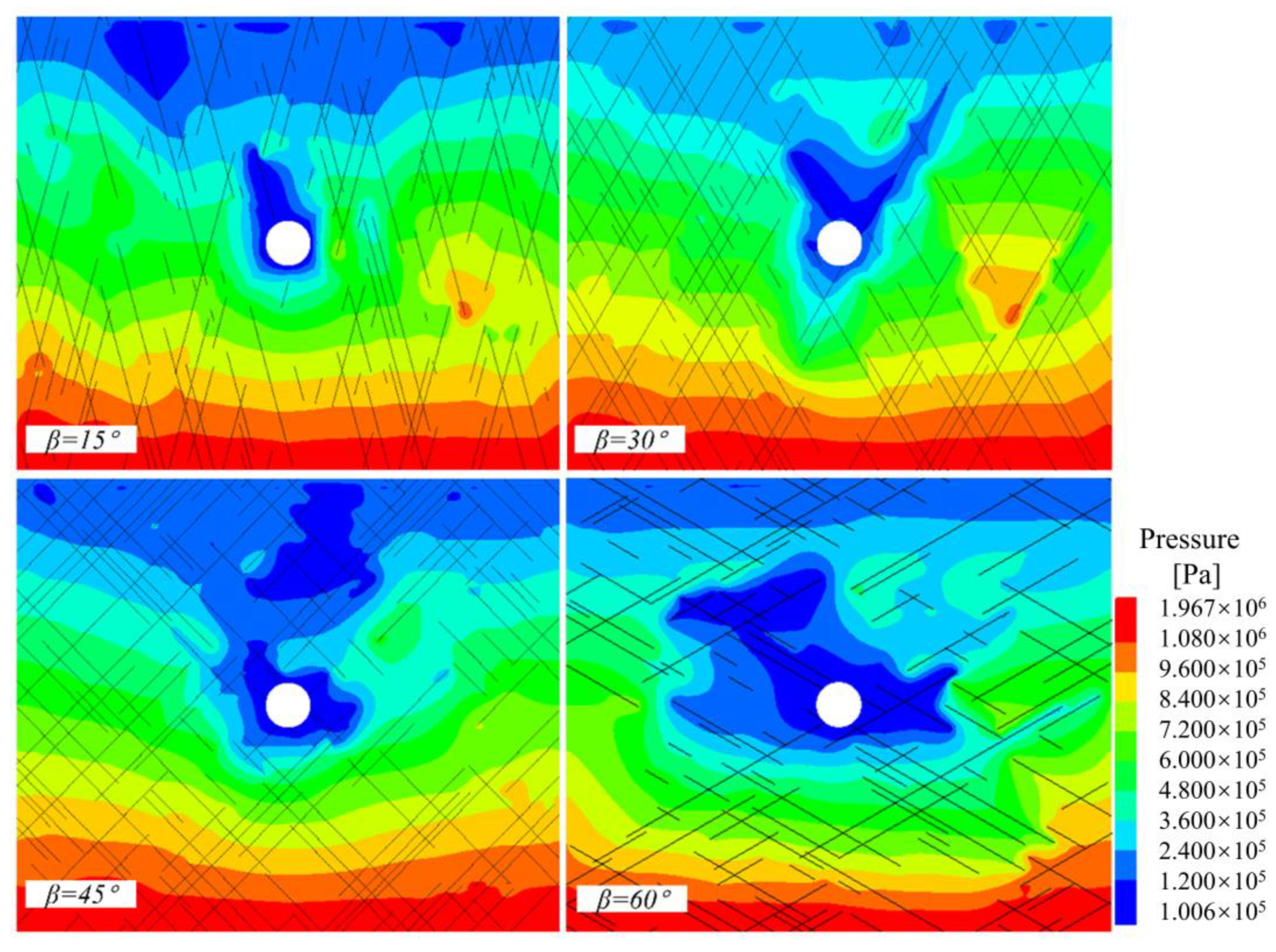


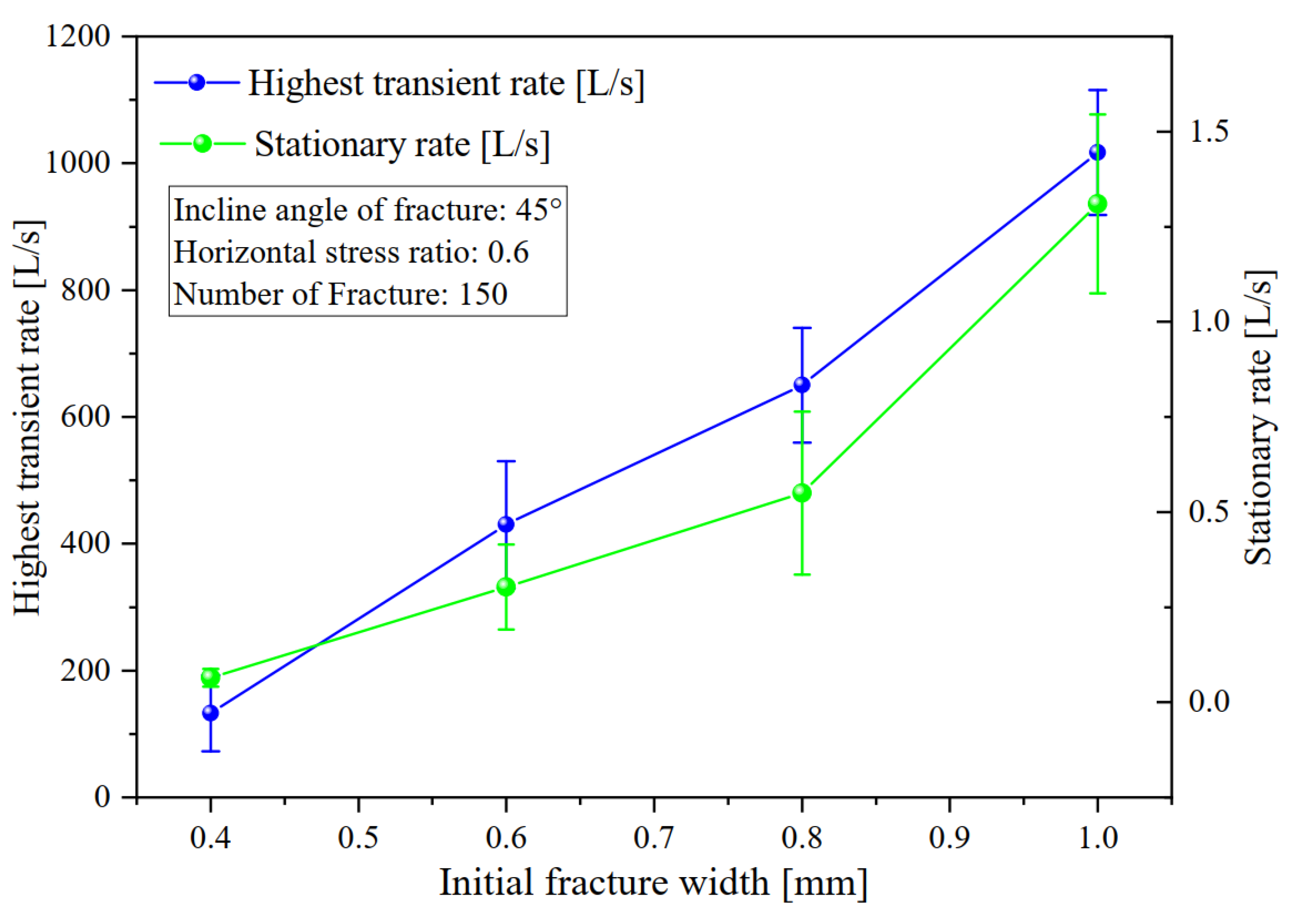
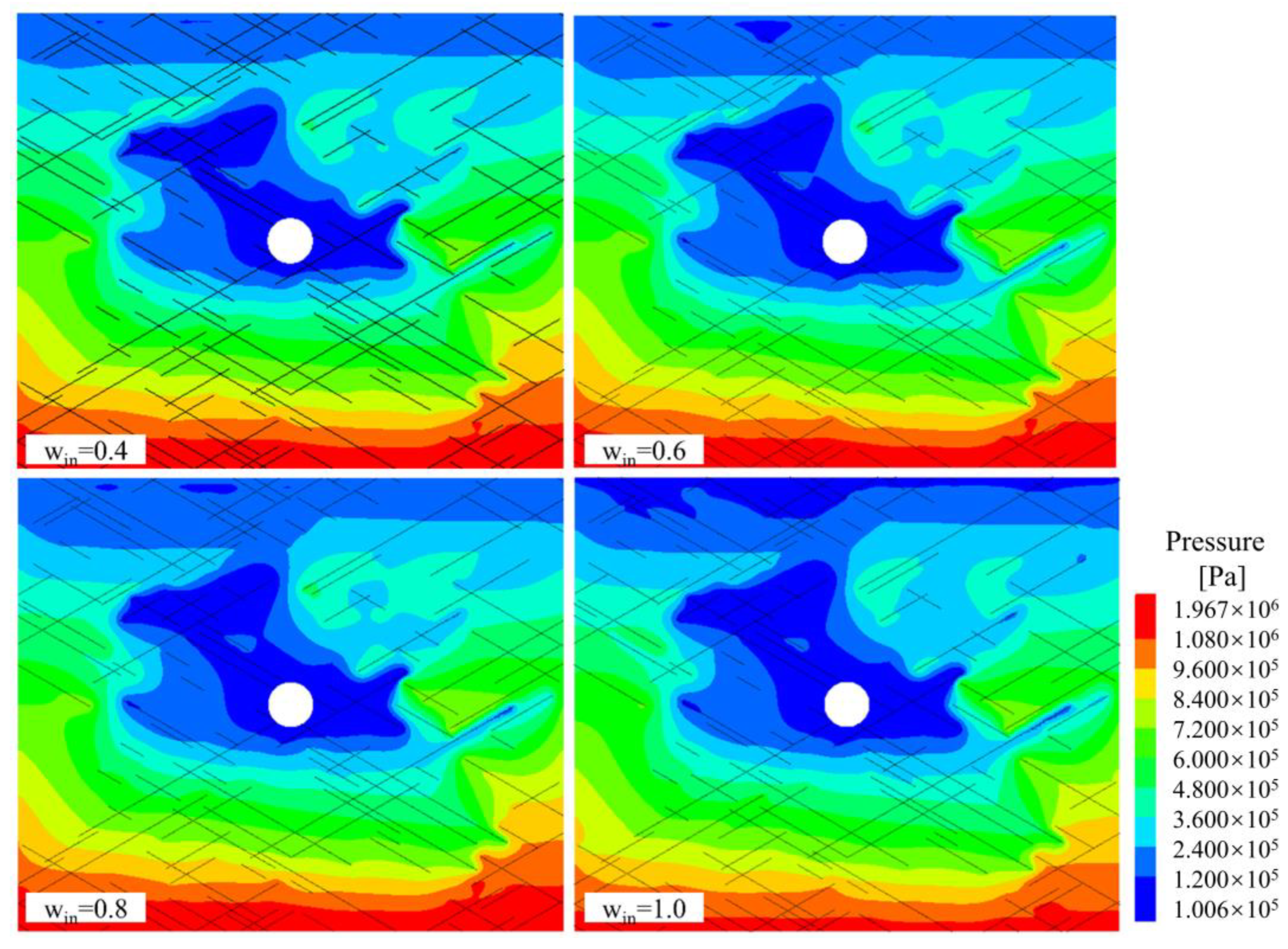
| Parameter | Unit | Value | Data Source and Note |
|---|---|---|---|
| Young’s modulus E | GPa | 15 | Labor test |
| Poisson ratio v | - | 0.25 | Labor test |
| ° | 25 | Modelling progressive failure in fractured rock masses using a 3D discrete element method | |
| Cohesion of fracture C | KPa | 0 | Modelling progressive failure in fractured rock masses using a 3D discrete element method |
| Permeability of intact rock kI | m2 | 10−15 | Labor test |
| % | 10 | Labor test | |
| Permeability of fractured rock kf | m2 | Equation (18) | Calculated |
| % | Equation (19) | Calculated | |
| Initial fracture width win | mm | 0.4 | Sensitive analysis |
| Numberer of fractures N | - | 150 | Sensitive analysis |
| Incline angle β | ° | 60 | Sensitive analysis |
| Horizontal stress ratio k0 | - | 0.6 | Sensitive analysis |
Disclaimer/Publisher’s Note: The statements, opinions and data contained in all publications are solely those of the individual author(s) and contributor(s) and not of MDPI and/or the editor(s). MDPI and/or the editor(s) disclaim responsibility for any injury to people or property resulting from any ideas, methods, instructions or products referred to in the content. |
© 2023 by the authors. Licensee MDPI, Basel, Switzerland. This article is an open access article distributed under the terms and conditions of the Creative Commons Attribution (CC BY) license (https://creativecommons.org/licenses/by/4.0/).
Share and Cite
Li, G.; Li, C.; Liao, J.; Wang, H. A New Hydro-Mechanical Coupling Numerical Model for Predicting Water Inflow in Karst Tunnels Considering Deformable Fracture. Sustainability 2023, 15, 14703. https://doi.org/10.3390/su152014703
Li G, Li C, Liao J, Wang H. A New Hydro-Mechanical Coupling Numerical Model for Predicting Water Inflow in Karst Tunnels Considering Deformable Fracture. Sustainability. 2023; 15(20):14703. https://doi.org/10.3390/su152014703
Chicago/Turabian StyleLi, Guodong, Changlong Li, Jianxing Liao, and Hong Wang. 2023. "A New Hydro-Mechanical Coupling Numerical Model for Predicting Water Inflow in Karst Tunnels Considering Deformable Fracture" Sustainability 15, no. 20: 14703. https://doi.org/10.3390/su152014703
APA StyleLi, G., Li, C., Liao, J., & Wang, H. (2023). A New Hydro-Mechanical Coupling Numerical Model for Predicting Water Inflow in Karst Tunnels Considering Deformable Fracture. Sustainability, 15(20), 14703. https://doi.org/10.3390/su152014703









